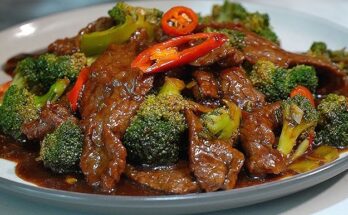Boiled Cabbage Recipe: Boiled cabbage is one of those humble dishes that manages to comfort your soul while nourishing your body.
Whether you’re whipping up a quick side dish or crafting a hearty main, boiled cabbage is easy to make, incredibly versatile, and surprisingly delicious when done right.
Today, we’re diving into a comprehensive, step-by-step guide to mastering the perfect boiled cabbage recipe. From picking the right cabbage to seasoning tips and serving ideas, this guide covers it all.
Why Boiled Cabbage is a Comfort Food Favorite
You might be wondering—what’s so special about boiled cabbage? Well, for starters, it’s been a staple in kitchens around the world for centuries. Boiled cabbage has a mild flavor that pairs beautifully with almost anything. Its soft, tender texture brings warmth and nostalgia to any meal, reminding many of childhood dinners or rustic home cooking.
Boiled cabbage is also incredibly adaptable. You can enjoy it plain with butter and salt or jazz it up with bacon, onions, and vinegar for a tangy twist. It’s gluten-free, affordable, and fits into most dietary lifestyles. Most importantly, it’s the kind of dish that feeds the belly and the heart at the same time.
Health Benefits of Eating Boiled Cabbage
Don’t let its simplicity fool you—cabbage is a powerhouse of nutrition. Boiling it not only enhances its digestibility but also unlocks some surprising health benefits. Here are just a few reasons you should consider adding boiled cabbage to your meal rotation:
- Rich in Vitamins: Cabbage is packed with vitamin C and K, both essential for immune support and bone health.
- High in Fiber: It supports digestive health, keeps you full longer, and helps regulate blood sugar levels.
- Low in Calories: If you’re watching your weight, cabbage is a great food to include—low in calories but high in nutrients.
- Anti-inflammatory Properties: Cabbage contains antioxidants like sulforaphane that reduce inflammation in the body.
- Heart Health: The potassium content in cabbage helps in lowering blood pressure and promoting cardiovascular wellness.
Ingredients You’ll Need
Let’s get into what you’ll need to make this dish sing. The beauty of boiled cabbage lies in its minimalism—you don’t need a fancy pantry to get this right.
Fresh and Simple Components
Here’s what you’ll need for the basic version:
- 1 medium green cabbage (you can also use red cabbage or savoy)
- 4 cups of water or broth (chicken or vegetable for more flavor)
- 1 tablespoon of salt (adjust to taste)
- 1 teaspoon black pepper
- 2 tablespoons butter or olive oil
- Optional: 1 chopped onion, 2 cloves garlic, dash of vinegar or lemon juice
That’s it! You probably already have most of these ingredients in your kitchen.
Tools and Equipment Needed
Before diving into the cooking process, make sure you have the right tools. Cooking cabbage isn’t complicated, but having the right equipment can make the experience smoother.
Kitchen Essentials for the Perfect Boil
- Large Pot or Dutch Oven: You’ll need something big enough to hold the cabbage and water without overflowing.
- Sharp Knife: For cutting the cabbage into wedges or shreds.
- Cutting Board: A stable surface for prepping your ingredients.
- Colander or Strainer: To drain the boiled cabbage easily.
- Slotted Spoon or Tongs: These will help you remove the cabbage without burning your hands.
- Measuring Spoons: For getting your seasoning right.
Now that you’re all set with your ingredients and tools, let’s jump into the actual cooking process.
Step-by-Step Guide to Making Boiled Cabbage
Mastering boiled cabbage isn’t rocket science—it’s just good cooking. Follow these simple steps and you’ll have a comforting, flavorful dish in no time.
Step 1 – Preparing the Cabbage
Start by selecting a fresh, firm cabbage. The outer leaves should be crisp and free of blemishes. Once you’ve chosen your cabbage, remove the outer leaves and rinse the head thoroughly under cold water. This step is essential to wash away any dirt or pesticides.
Next, place the cabbage on a cutting board and slice it in half through the core. Then cut each half again to make quarters. From here, you can either shred the cabbage thinly for a more delicate texture or cut it into larger chunks or wedges for a more traditional, hearty look.
Want to get fancy? Toss the chopped cabbage in a bowl of cold water for 5–10 minutes to help retain its color and crispness during boiling. Then drain thoroughly using a colander.
Step 2 – Boiling the Cabbage
Fill a large pot or Dutch oven with water or broth. Add a generous pinch of salt to the liquid—it’s the only chance you’ll get to season the cabbage from the inside out. Bring the water to a boil over high heat.
Once boiling, gently add the cabbage. Reduce the heat to medium and let it simmer uncovered for about 10–15 minutes. If you’re using shredded cabbage, check it at the 8-minute mark; for wedges or larger chunks, let it cook a bit longer, around 20 minutes.
Keep an eye on the cabbage—it should be tender but not mushy. You want that sweet spot where a fork can easily pierce it, but it still holds its shape.
Step 3 – Seasoning and Serving
Now comes the fun part—flavor! Drain the cabbage well and return it to the pot or a large bowl. Add your butter or olive oil and gently toss to coat each piece evenly. Want to kick it up a notch? Sprinkle in black pepper, a dash of vinegar, or a squeeze of lemon juice for brightness.
If you’re feeling indulgent, mix in sautéed onions and garlic, or even bacon crumbles for a smoky punch. Boiled cabbage absorbs flavor like a sponge, so don’t be afraid to get creative.
Serve hot as a side dish, mix it into mashed potatoes for a rustic twist, or eat it on its own with a spoon—it’s that good.
Tips for the Best Texture and Flavor
Let’s be real—boiled cabbage can be bland or mushy if done wrong. Here are some tips to ensure your cabbage turns out delicious every single time:
- Use broth instead of plain water to give the cabbage a deeper flavor base.
- Don’t overcook it. Once the cabbage turns soft, it’s ready. Anything beyond that and it turns into mush.
- Add seasoning during the boil—a bit of salt, pepper, or bay leaf goes a long way.
- Toss in aromatics like onions, garlic, or a hint of vinegar during the boil for a layered flavor.
- Finish with fat. Whether it’s butter, olive oil, or even ghee, fat adds richness and helps carry the flavor.
- Don’t skip the acid. A little lemon juice or vinegar brightens the dish and balances the richness.
Perfect boiled cabbage is all about balance—texture, flavor, and temperature need to work together to create something truly crave-worthy.
Common Mistakes to Avoid
If you’ve ever had boiled cabbage that turned out gray, soggy, or just…meh, you’re not alone. Here are the most common pitfalls and how to dodge them:
- Boiling Too Long: Overcooked cabbage becomes mushy and loses its natural sweetness. Stick to the suggested cooking time.
- Using Too Little Water: Not enough water can cause uneven cooking and browning. Make sure the cabbage is fully submerged.
- Skipping the Salt: Salt enhances the natural flavor of the cabbage—without it, you’ll end up with a bland dish.
- Not Draining Properly: Excess water can make your cabbage soggy. Always drain it thoroughly.
- Forgetting to Season After Cooking: Boiled cabbage soaks up post-cooking flavors, so don’t skip the butter, pepper, and acidity.
By avoiding these mistakes, you’ll ensure your cabbage dish is one people go back for seconds… and thirds.
Variations to Try
Boiled cabbage doesn’t have to be boring. With just a few tweaks, you can transform this humble dish into something truly memorable. Whether you’re looking to add some protein, spice it up, or give it an international twist, the possibilities are endless.
Adding Proteins
Adding a protein source to boiled cabbage can turn it from a side dish into a full-fledged meal. Here are a few delicious combos to consider:
- Bacon or Ham: A classic Southern-style twist. Fry bacon until crispy, set it aside, and use the drippings to cook onions or garlic before adding them to the boiled cabbage. Then crumble the bacon back in. Smoky and savory!
- Sausage: Whether it’s spicy Italian, bratwurst, or kielbasa, sausage pairs incredibly well with cabbage. Slice and pan-fry it separately, then mix it in.
- Ground Meat: Brown ground beef, turkey, or chicken and mix it with the boiled cabbage for a quick and hearty skillet meal.
- Beans: For a vegetarian or vegan protein source, add cooked chickpeas, white beans, or lentils. They blend well and boost the nutrition.
This is a great way to customize the dish based on what you have in your fridge or pantry.
Spicing It Up
If you like bold flavors, you can kick your boiled cabbage up a notch with spices and global seasonings:
- Garlic and Chili Flakes: A touch of heat goes a long way. Add them while sautéing aromatics for a spicy twist.
- Curry Powder or Turmeric: For an Indian-inspired version, stir in a teaspoon of curry powder or turmeric along with some cumin seeds.
- Smoked Paprika: This spice gives a warm, smoky flavor that pairs beautifully with cabbage.
- Soy Sauce and Ginger: Looking for an Asian-inspired twist? Add these along with sesame oil for a flavorful fusion dish.
Get creative! Cabbage is like a blank canvas—it takes on flavor beautifully.
What to Serve with Boiled Cabbage
Boiled cabbage might be the star of the show, but it loves good company. Here are some tried-and-true pairings:
- Mashed Potatoes: Classic, creamy mashed potatoes are perfect for soaking up the juices from cabbage.
- Cornbread or Soda Bread: These hearty breads are perfect for scooping up every last bite.
- Roast Meats: Whether it’s a roast chicken, pork chops, or beef brisket, boiled cabbage complements rich meats with ease.
- Rice or Grains: Serve over a bed of rice, quinoa, or farro for a healthy, balanced bowl.
You can also use boiled cabbage in more inventive ways: stuff it into tacos, stir it into noodle bowls, or even use it as a topping for toast. Seriously, don’t knock it ’til you try it.
How to Store and Reheat Boiled Cabbage
Let’s face it—boiled cabbage makes excellent leftovers. The flavor often deepens overnight, making it even more delicious the next day. Here’s how to store and reheat it properly:
- Storage: Allow the cabbage to cool completely. Transfer to an airtight container and store in the refrigerator for up to 4 days.
- Freezing: Cabbage freezes well. Place in freezer-safe containers or bags, remove as much air as possible, and freeze for up to 3 months.
- Reheating: Warm on the stove over medium heat until hot, or microwave in 1-minute intervals, stirring in between. Add a splash of broth or water to loosen it up if needed.
Don’t forget to taste and adjust the seasoning after reheating—it often needs a little boost!
Nutritional Information
Boiled cabbage is not just tasty—it’s also good for you. Here’s a general breakdown for one serving (about 1 cup) of plain boiled cabbage:
| Nutrient | Amount |
|---|---|
| Calories | 33 kcal |
| Protein | 1.3 g |
| Fat | 0.1 g |
| Carbohydrates | 7.7 g |
| Fiber | 2.9 g |
| Vitamin C | 32% of RDI |
| Vitamin K | 85% of RDI |
| Folate | 10% of RDI |
| Potassium | 151 mg |
Keep in mind these values can vary depending on what you add—like butter or bacon—but even jazzed-up versions are generally pretty healthy.
Gluten-Free and Vegan Options
One of the best things about boiled cabbage? It’s naturally gluten-free and super easy to make vegan-friendly. You don’t have to sacrifice flavor to accommodate different dietary needs.
- Vegan Version: Simply skip the butter and use olive oil, avocado oil, or vegan butter instead. Add depth by sautéing garlic or shallots in the oil before mixing it in with the cabbage.
- Flavor Boosters for Vegans: Try adding nutritional yeast for a cheesy, umami flavor. A splash of soy sauce or tamari (gluten-free) can also bring saltiness and depth.
- Gluten-Free Assurance: Boiled cabbage is already gluten-free as long as your broth, seasonings, and any additional ingredients (like sausage or bacon) are verified gluten-free. Always read labels if you’re cooking for someone with celiac disease or gluten intolerance.
With a few simple swaps, this classic dish can fit seamlessly into almost any diet plan.
FAQs about Boiled Cabbage Recipe
1. Can I boil red cabbage the same way as green cabbage?
Yes! Red cabbage can be boiled just like green cabbage. Just note that it will release a purple hue into the water and surrounding food. Add a splash of vinegar to help retain its color.
2. How do I keep boiled cabbage from smelling bad?
The strong smell usually comes from overcooking. Stick to the recommended cook times and consider adding a splash of vinegar or lemon juice to reduce the odor.
3. Can I use boiled cabbage in other recipes?
Absolutely. Use it in stir-fries, soups, wraps, tacos, or as a bed for meats. It’s a great addition to many dishes.
4. Is it better to boil cabbage whole or chopped?
Chopped or quartered cabbage cooks more evenly and quickly. Boiling it whole can lead to uneven cooking and longer times.
5. How do I make boiled cabbage more flavorful?
Use broth instead of water, add aromatics like garlic or onions, and finish with butter or oil. A touch of acid like lemon juice or vinegar also enhances flavor.
Final Thoughts
Boiled cabbage may not be the flashiest dish on the table, but it’s a time-tested classic that delivers on flavor, nutrition, and comfort. It’s affordable, versatile, and endlessly customizable. Whether you’re cooking it as a humble side dish or jazzing it up with proteins and spices for a full meal, there’s no denying its value in any kitchen.
The next time you’re staring at a head of cabbage and wondering what to do with it, go ahead—boil it. Just follow the steps, season with heart, and enjoy the comforting simplicity of one of the most underrated vegetables around.



